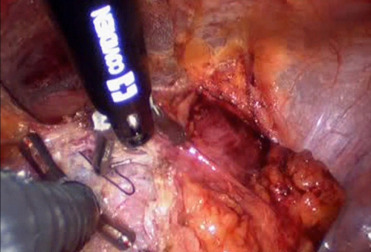Abstract
Laparoendoscopic single site surgery (LESS) has been accompanied by the development of a new generation of purpose-built optics and instruments. Despite all these, suturing still represents a challenge in LESS. The authors describe a technique of urachal cyst excision by LESS, with extramucosal partial cystectomy and cystorrhaphy performed with the SILS™ Stitch instrument. The technique is safe and feasible, offering the advantages of reducing the number of abdominal incisions to one that can be hidden in the umbilicus, with less post-operative pain and improved cosmesis. The extramucosal technique shortens the period of postoperative catheterization and hospitalization.
Resumo
A cirurgia de porta única (LESS) tem vindo a ser acompanhada pelo desenvolvimento de uma nova geração de óticas e instrumentos adaptados ao efeito. Contudo, a realização de sutura mantém-se um desafio na porta única. Os autores descrevem a sua técnica de excisão de quistos do úraco por LESS, através de cistectomia parcial extramucosa e cistorrafia com o auxílio do SILS™ Stitch instrument. O procedimento é exequível e seguro, reduzindo a uma o número de incisões abdominais, que pode ficar escondida no umbigo, com melhoria da cosmese e redução de dor pós-operatória. A técnica extramucosa reduz o tempo de algaliação e hospitalização.
Keywords
LESS; Urachal cyst; Extramucosal partial cystectomy; Stitch instrument
Palavras-chave
Porta única; Quisto do úraco; Cistectomia parcial extramucosa; Dispositivo de sutura
Laparoendoscopic single site surgery (LESS) represents a progression in laparoscopic surgery and is reported with increasing frequency. However, it defies the most basic laparoscopic concepts, including triangulation of working instruments and external spacing to decrease clashing. To overcome technical limitations related to LESS, industries have also developed a new generation of purpose-built optics and instruments. Articulating instruments have been conceptually developed to allow the surgeons hands to be positioned farther apart while some triangulation is internally created. Despite all these, suturing still represents a challenge in LESS. The SILS™ Stitch instrument is specially designed to make suturing easier in LESS surgeries.
Technique description
We describeour technique of LESS in urachal cyst excision, using a SILS™ port. The patient was placed in the supine, 30° Trendelenburg position during the procedure. With the transumbilical open Hasson technique, a 2–2.5 cm vertical intraumbilical skin incision was made. Two tissue forceps were placed to evert both edges of the incision. A vertical midline anterior rectus fasciotomy was made, the abdominal cavity was entered, and a sweep of the finger verified lack of underlying adhesions. The lower edge of the SILS port was grasped via curved artery forceps, and then a lubricant was placed. The port was then deployed and secured in place. The 12 mm cannula was placed by its obturator followed by the two 5 mm cannulas. These cannulas (ports) were placed at different heights to reduce instruments clashing. The port had an insufflation channel which was connected to the insufflation line to achieve CO2 pneumoperitoneum to a pressure of 12 mmHg. A 5 mm 30° lens was introduced through the cannula for inspection of the abdominal cavity, followed by the articulating instruments to dissect the urachal remnants and perivesical cyst. Extramucosal partial cystectomy was performed with a 5 mm LigaSure™. The cystorrhaphy was performed by the 12 mm port with the SILS Stitch instrument, to offer precise access to the surgical site, with distal shaft articulation, needle jaw tip rotation, combined with the instruments proprietary toggle-activated needle-passing feature (Fig. 1). No drain was placed. The operative time was 50 min and vestigial blood loss. The patient was discharged after 24 h, catheter-free, with no immediate complications and a 3 months follow-up showed patient satisfaction with good cosmesis. Video available at http://tinyurl.com/nbmuex5.
|
|
|
Figure 1. Detail of cystorrhaphy with SILS™ Stitch instrument. |
Conclusions
SILS urachal cyst excision and cystorrhaphy has proved to be safe and feasible, using specially designed ports and instruments. Similar to other procedures, it offers the advantages of reducing the number of abdominal incisions to one that can be hidden in the umbilicus, with less post-operative pain and improved cosmesis. The extramucosal technique shortens the period of postoperative catheterization and hospitalization.
Ethical disclosures
Protection of human and animal subjects
The authors declare that no experiments were performed on humans or animals for this study.
Confidentiality of data
The authors declare that no patient data appear in this article.
Right to privacy and informed consent
The authors declare that no patient data appear in this article.
Conflicts of interest
The authors have no conflicts of interest to declare.
Document information
Published on 31/08/16
Licence: Other
Share this document
Keywords
claim authorship
Are you one of the authors of this document?
